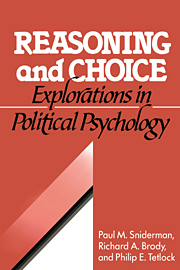Book contents
- Frontmatter
- Contents
- List of tables and figures
- Preface
- 1 Introduction: major themes
- 2 The role of heuristics in political reasoning: a theory sketch
- 3 Values under pressure: AIDS and civil liberties
- 4 The principle–policy puzzle: the paradox of American racial attitudes
- 5 Reasoning chains
- 6 The likability heuristic
- 7 Democratic values and mass publics
- 8 Ideological reasoning
- 9 Information and electoral choice
- 10 Stability and change in party identification: presidential to off-years
- 11 The American dilemma: the role of law as a persuasive symbol
- 12 Ideology and issue persuasibility: dynamics of racial policy attitudes
- 13 The new racism and the American ethos
- 14 Retrospect and prospect
- Notes
- Bibliography
- Subject index
- Author index
11 - The American dilemma: the role of law as a persuasive symbol
Published online by Cambridge University Press: 05 May 2010
- Frontmatter
- Contents
- List of tables and figures
- Preface
- 1 Introduction: major themes
- 2 The role of heuristics in political reasoning: a theory sketch
- 3 Values under pressure: AIDS and civil liberties
- 4 The principle–policy puzzle: the paradox of American racial attitudes
- 5 Reasoning chains
- 6 The likability heuristic
- 7 Democratic values and mass publics
- 8 Ideological reasoning
- 9 Information and electoral choice
- 10 Stability and change in party identification: presidential to off-years
- 11 The American dilemma: the role of law as a persuasive symbol
- 12 Ideology and issue persuasibility: dynamics of racial policy attitudes
- 13 The new racism and the American ethos
- 14 Retrospect and prospect
- Notes
- Bibliography
- Subject index
- Author index
Summary
The chapters so far have drawn on the two broadly available survey series: the National Election Studies and the General Social Survey. Both have a definite shape to their data designs – fixed-instrument and face-to-face interviews. In contrast, the succeeding chapters draw on surveys we have ourselves designed, and these have a deliberately different shape – variable instrument and over the telephone.
The first feature is crucial, the second merely material. Our interviews have been conducted over the telephone since this is, at the moment, the easiest way to take advantage of computer-assisted interviewing. But the key is computerassisted interviewing.
The decisive advantage of computer-assisted interviewing is variability. Introductions to questions can vary. The wording of the actual question can vary. So, too, can the order of questions and the formatting of responses. In the chapters that follow we illustrate how to capitalize on this variability to illuminate aspects of reasoning about political choices hitherto out of sight.
We start, in Chapter 11, with the most straightforward form of variation. The questions we want to address are these. To what extent can ordinary citizens be rallied in support of a policy intended to assist blacks if they know that the policy is not merely a possible course of action but has actually the force of law? And supposing the law can operate as a persuasive symbol, why are some people more willing to rally behind it than others?
The key to addressing these questions, we are persuaded, is integrating experimental design and survey research. Most generally, the idea is to combine the internal validity strengths of experimental design with the external validity strengths of representative sampling. […]
- Type
- Chapter
- Information
- Reasoning and ChoiceExplorations in Political Psychology, pp. 206 - 222Publisher: Cambridge University PressPrint publication year: 1991
- 1
- Cited by



